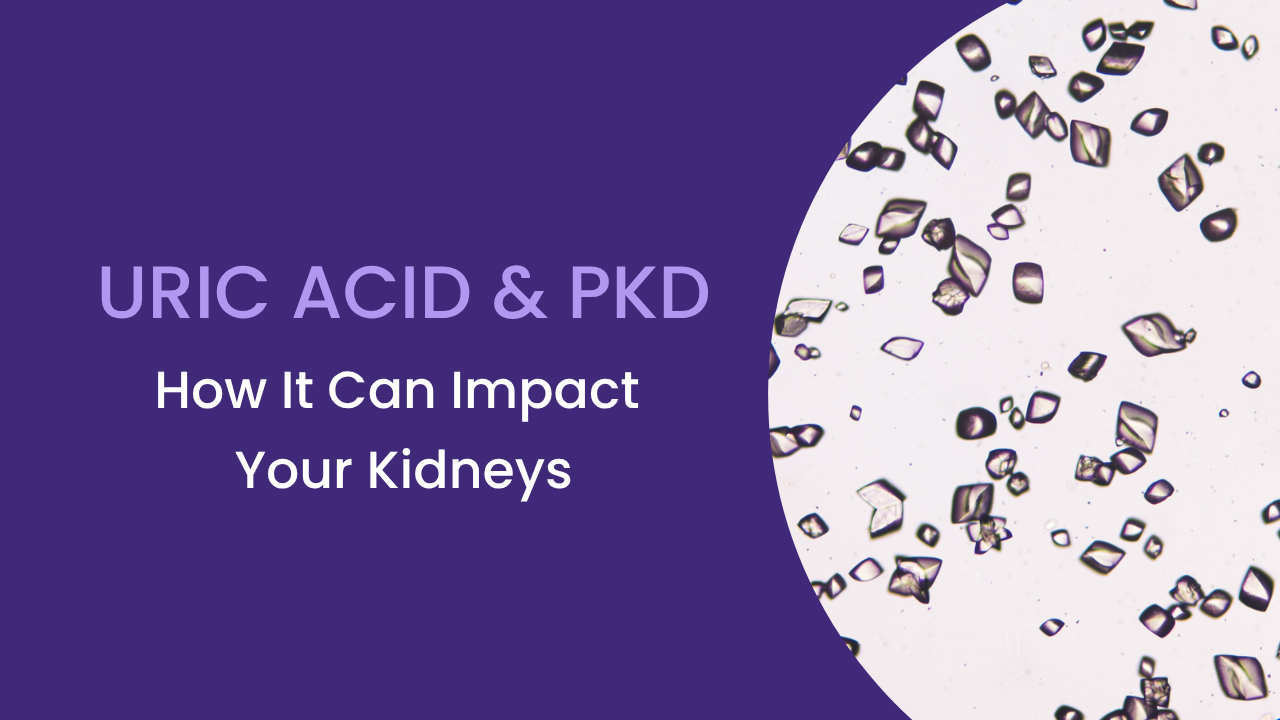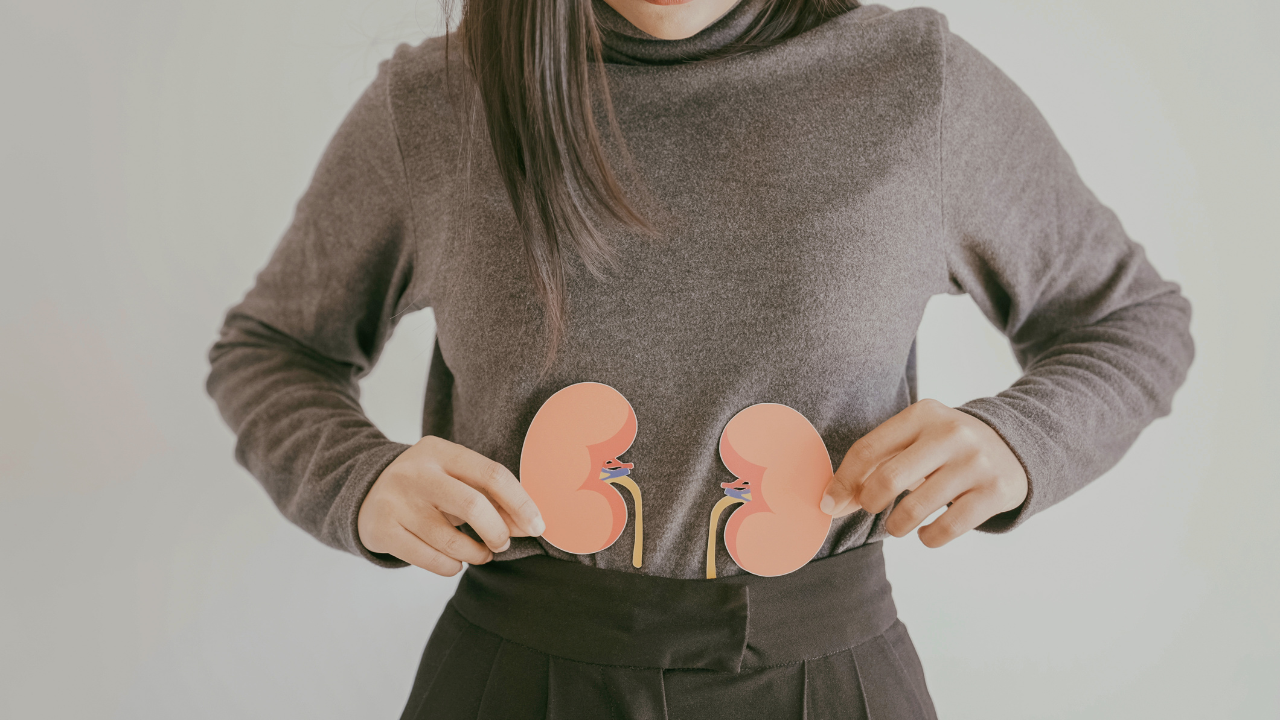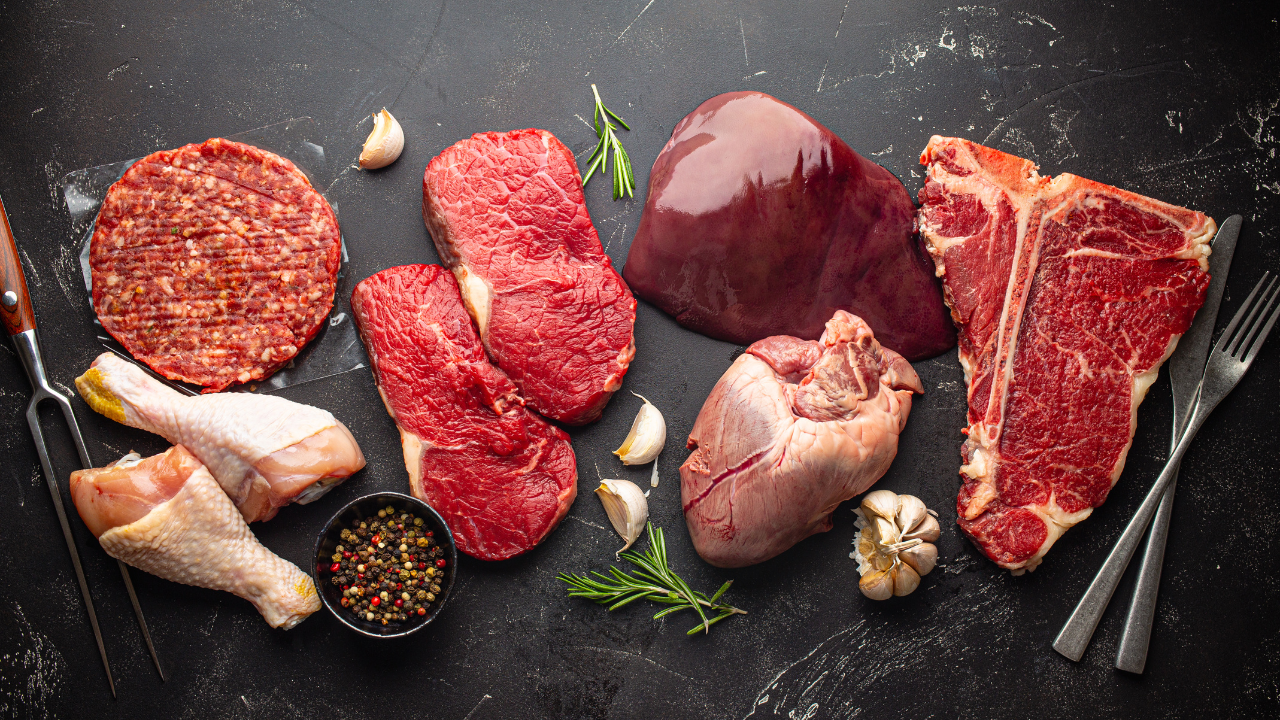
Uric Acid and Polycystic Kidney Disease (PKD): How It Can Impact Your Kidneys
Nov 13, 2025Uric acid (UA) is a natural waste product that the kidneys are responsible for filtering out of your blood. In fact, up to 70% of the uric acid in your body is removed by your kidneys! But where does uric acid waste come from, and why does it matter for people living with Polycystic Kidney Disease (ADPKD)?
In this blog, we’ll dive into what uric acid is, how it’s produced, what happens when uric acid get too high, and factors outside of kidney function that can affect your levels. Of course, we’ll also touch on dietary sources of purines and practical ways to manage UA.
By the end, you’ll understand why monitoring uric acid levels is important for PKD and what could be impacting your lab results.
Uric Acid Basics
Produced by the Body
Uric acid is formed when your body breaks down something called purines, which are compounds found in certain foods and produced naturally by your body’s cells. Purines themselves aren’t waste, they play a role role in cell growth, energy production, and metabolic signaling in your body. When purines are broken down, uric acid is produced as a waste product.
While an estimated 70% of your uric acid is naturally produced by your body, the other 30% comes from your diet (more on that in a bit).
Filtered by the Kidneys
Normally, uric acid waste is filtered out by the kidneys, and is eliminated through urine. But if your kidneys are damaged or not working at full capacity, as is often the case with PKD, uric acid can build up at higher levels in the blood; this is called hyperuricemia.

Frequently, clients of mine have never had their Uric Acid level tested. It is a lab I always encourage them to ask for, to get a baseline level, and to request added annually to monitor. Too often, with uric acid, many folks discover their is an issue only after a gout flare or the discover, or passing, or a kidney stone. With my clients, sometimes those uric acid labs come back more than expected, highlighting an area we can work on with diet and lifestyle changes. An opportunity to support PKD health, kidney health, and to work towards reducing uric acid levels.
Understanding Uric Acid Lab Values
As listed on your labs, uric acid has a pretty wide range that is considered normal. The "Normal" reference ranges for uric acid are:
- Men: 2.5-7.0 mg/dL
- Women: 1.5-6.0 mg/dL
- *Reference ranges can vary by lab
Just because levels are listed as "normal" doesn't mean they are optimal. For example, with a diagnosis of gout and treatment with medication like Allopurinol, a target goal is UA less than 6.0 mg/dL. For men, anything about 6.0 mg/dL is considered hyperuricemia. For women, anything about 6.0 is considered high. It's best to ask your MD what a good goal is for you.
When Uric Acid Levels Get Too High
Elevated levels of uric acid in the blood usually happens because of two things. Either your body produces too much or your kidneys don't remove enough. Of course it could, and often is, caused by a combination of the two. Other factors that can contribute to elevated levels include dehydration, certain medications, genetics, diet, obesity, gut health issues and reduced kidney function.
Complications of high uric acid:
- Gout (a painful buildup of crystals in joints)
- Kidney stones
- Inflammation
- Kidney injury
- Accelerated PKD progression

Uric Acid and Polycystic Kidney Disease
An estimated 60% of people with Polycystic Kidney Disease have elevated blood levels of uric acid (hyperuricemia). Elevated uric acid is linked to faster cyst growth, PKD progression, and larger kidneys. The why behind this isn’t fully understood. It’s either increased production or decreased removal.
It’s unclear if elevated levels cause PKD to progress faster or are a consequence of PKD progression and kidney injury. It looks to be a combination of both. Studies have shown that people with intact kidney function, a "normal" eGFR, have elevated uric acid levels. There for sure is something about PKD that leads to elevated levels, hopefully the science of it all becomes more apparent in the near future.
One thing is clear, though: higher serum uric acid levels are associated with larger kidney volumes. With PKD, elevated levels of uric acid can contribute to increased inflammation, kidney stones, and kidney damage. This makes uric acid something to pay attention to with PKD, to address with diet and lifestyle, and one of your opportunities to reduce, remove or replace to support PKD kidney health.
Gout and PKD
When uric acid levels are high in the blood, needle-shaped crystals can form. Complications occur when these crystals get deposited in soft tissues, joints, or the kidneys. The buildup of crystals in joints is called gout, a pain that often shows up first in someone's right big toe. An estimated 24% of people with PKD have gout.
Now, just because uric acid levels are high, this doesn’t automatically mean you have gout - it is really only diagnosed after a gout flare or with symptoms. Common symptoms of gout include sudden, intense joint pain (often in that right big toe), swelling, redness, warmth, and tenderness around the affected area.
With PKD, it’s recommended to medically treat elevated uric acid levels only if there are symptoms or gout is present. Studies have shown that proactively lowering uric acid levels with medication did not significantly impact cyst growth and help slow PKD progression.

Uric Acid Stones and PKD
Excess uric acid (UA) crystals can also lead to the formation of kidney stones. Factors like low urinary citrate and acidic urine—common with PKD—increase this risk. Not only are kidney stones incredibly painful; they can trigger inflammation and cause lasting kidney damage. In fact, the frequency of uric acid stones is 40-60% higher with PKD compared to the general population.
Curious why PKD is connected with a higher stone risk? Check out my blog on PKD and Kidneys Stones.
Uric Acid and PKD Pathways
When uric acid levels rise too high, the excess can crystallize, leading to inflammation and direct damage to kidney tissue. These crystals—including uric acid crystals—also activate the mTOR pathway, a key driver of cyst growth in PKD. Since your kidneys are already under stress, this additional damage can speed up PKD disease progression.
It's worth noting, in studies like CRISP, elevated uric acid was not an independent risk factor for increased kidney volume. This just means it wasn't a direct cause all by itself, but there was a connection noted for sure. In short: too much uric acid → crystal formation → kidney injury.
High Uric Acid levels are associated with:
- Earlier hypertension
- Cyst growth
- Faster PKD progression
- Greater total kidney volume (TKV)

Dietary Sources of Uric Acid
As mentioned earlier, about 30% of your body's uric acid comes from diet. More specifically, the breakdown of purines that are in the food we eat. A dietary pattern that is rich in purines, one that is meat-heavy, can increase uric acid waste. Folks, this is modifiable. Meat is the main source of purines in our diets.
How much protein is a good amount for you, and what type you eat do matter for PKD. This doesn't mean you need to become a vegan or even a vegetarian, just one more example supporting balanced protein intake that is individualized to you and your life. Anyone who promotes meat-heavy diets for PKD and also says to limit purine-rich foods....well, that makes zip zero sense!
The Top 8 Purine-Rich Foods:
- Organ meats (liver, kidney, sweetbreads)
- Sardines
- Anchovies
- Mackerel
- Mussels
- Red meat (beef, lamb, pork)
- Game meats (venison, duck, goose)
- Shellfish (shrimp, crab, lobster)
Alcohol and sugary processed food, especially those containing high-fructose corn syrup (HFCS), like soda and sweetened juice, can increased uric acid levels and trigger gout flares.
While plants do contain purines, eating them doesn't increase uric acid levels the way purine-rich meat consumption does.

In general, good dietary patterns if you have gout or elevated uric acid levels are:
- Increase fluid intake, good hydration
- Moderate protein, avoid high intake
- Limit food high in purines - heavy meat consumption
- Eat more plants & produce
- Limit sugary drinks, avoid high-fructose corn syrup (HFCS)
- Alcohol in moderation
Of course, its best to work with your dietitian when it comes to nutrition and dietary changes. Work with your RD to create an intentional, and targeted plan to address the gout, stone or uric acid issue.
Other Factors That Impact Uric Acid Levels
Several other factors that can impact your levels of uric acid, either by making more or removing less, that aren’t kidney-specific are:
Hormones
For women, estrogen provides natural protection against high uric acid levels. During perimenopause, declining estrogen levels can lead to gradual increases in uric acid. If you're a woman in your 40s - 50's and notice your uric acid creeping up despite no other obvious changes, hormonal shifts might be the culprit.
Medication
Several medications can also raise uric acid levels, including Tolvaptan (Jynarque), which is currently the only FDA-approved medication for ADPKD. Because starting Tolvaptan (Jynarque) may increase uric acid levels it should should be used with caution in people with preexisting gout. Other medications, commonly used with PKD, that can increase uric acid are thiazide diuretics (HCTZ), low-dose aspirin, and some blood pressure medications, like lisinopril.
Gut Health
Your gut isn’t just for digestion—it also helps regulate uric acid. About 30% of uric acid waste is removed by your gut - through your intestines! Unhealthy or imbalanced gut bacteria, known as dysbiosis, is linked to high uric acid levels, leaving more uric acid for your kidneys to filter.
Some of the beneficial bacteria in our guts actually help to break down uric acid which help to reduce its levels in the body. Supporting gut health—through fiber-rich foods, fermented foods, and maintaining a diverse microbiome—may help your body manage uric acid more effectively and reduce kidney stress.
Treatment of Hyperuricemia With PKD
The current recommendation, and best practice for PKD, is to only treat elevated uric acid with medication when gout and/or symptoms are present. Otherwise, without any symptoms dietary and lifestyle changes are recommended. These include limiting alcohol, high fructose corn syrup (HFCS), reducing intake of purine-rich foods, practicing good hydration habits, and maintaining a healthy weight.
In Summary
Uric acid is a natural waste product from both your body and your diet. Too much can contribute to gout, kidney stones, and inflammation—all of which can affect PKD progression. Many people don’t know their uric acid levels until a gout flare or a kidney stone shows up.
With PKD, elevated uric acid is typically only treated medically if symptoms appear—but keeping an eye on your levels gives you a real opportunity to protect your kidneys and manage potential risk proactively. If you’re unsure of your levels, get tested and monitor those trends.
References
- https://pubmed.ncbi.nlm.nih.gov/32807060/
- https://pubmed.ncbi.nlm.nih.gov/41208250/
- https://pmc.ncbi.nlm.nih.gov/articles/PMC7887140/
- https://pubmed.ncbi.nlm.nih.gov/3354568/
- https://pubmed.ncbi.nlm.nih.gov/3354568/
- https://pubmed.ncbi.nlm.nih.gov/36815099/
- https://pubmed.ncbi.nlm.nih.gov/38900704/
- https://pubmed.ncbi.nlm.nih.gov/2368793/
- https://pubmed.ncbi.nlm.nih.gov/2923134/
- https://pubmed.ncbi.nlm.nih.gov/15014182/
- https://pubmed.ncbi.nlm.nih.gov/15474873/
- https://pmc.ncbi.nlm.nih.gov/articles/PMC4370296/
- https://pubmed.ncbi.nlm.nih.gov/36506033/
- https://www.mdpi.com/2798044
- https://pmc.ncbi.nlm.nih.gov/articles/PMC8851145/
- https://pubmed.ncbi.nlm.nih.gov/8213789/
- https://pubmed.ncbi.nlm.nih.gov/41208250/

